
The great composer and conductor, Gustav Mahler (1860-1911), lived in or visited Vienna at various times during his life. He also died here.
Use the info, links and map below to find your way to the more resonant sites associated with his work and music in the city.
- See also:
Mahler: his life
Mahler remains indelibly connected to Vienna through his tenure in charge of the State Opera House (Staatsoper), where he served as director from 1897 to 1907. Experts credit him with turning the Hofoper (as it was then called) into a world-class institution.
Auenbruggergasse 2
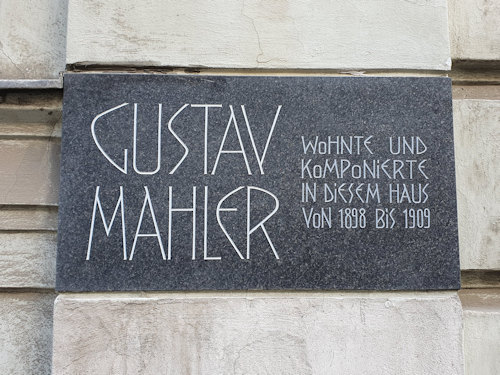
(A plaque reminds us of the famous resident)
Mahler lived for most of his time as director in an apartment on Auenbruggergasse opposite Lower Belvedere Palace.
Otto Wagner designed the building around 1890, and a small plaque outside reminds passersby of its one-time famous musical occupant. The text reads (my translation):
Gustav Mahler lived and composed in this house from 1898 to 1909
The same architect built himself a home out in the woods in the late 1880s, where he also entertained guests that included Mahler and Gustav Klimt.
The Otto Wagner villa is open to the public as the Ernst Fuchs Museum. Little of the original interior survives, but the room known as the Adolf Böhm-Saal remains largely as it was in Mahler’s time.
Karlskirche
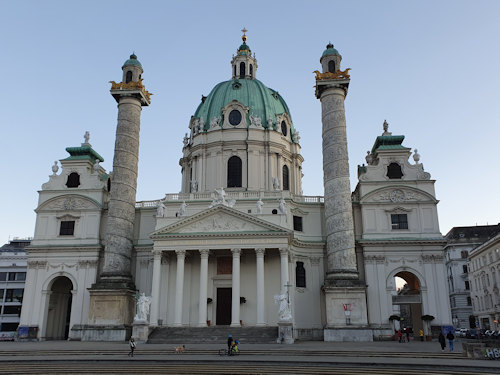
(The church also serves as a concert venue today)
The beautiful 1737 Karlskirche church towers over Karlsplatz square. Gustav Mahler married Alma Schindler here in March 1902.
According to a newspaper report of the time, the ceremony lasted around 10 minutes with hardly anybody in attendance. One guest, though, was the famous painter Carl Moll, who also happened to be the bride’s stepfather.
Mahler’s death

(A plaque marks the location of Mahler’s final day)
After a short period in the USA, a seriously-ill Mahler returned to Vienna from New York in May, 1911, and was taken immediately to the Loew Sanitorium in Vienna’s 9th district. He died there just a few days later on May 18th.
A plaque outside the building at Mariannengasse 20 commemorates the sad event. It simply says (my translation):
Gustav Mahler died in this house on May 18th, 1911
Below the statement and a brief line of music are the names of those who presumably organised the plaque: the city of Vienna, the Wiener Philharmoniker orchestra, and the International Gustav Mahler Society (whose premises and archives are in Vienna’s 4th district at Wiedner Gürtel 6/2).
Mahler’s grave

(The cemetery is out in one of the more upmarket suburbs)
The funeral took place on May 22nd at Grinzing cemetery in Vienna’s 19th district. Among the guests: Gustav Klimt and Arnold Schoenberg.
Mahler’s grave consists of little more than a large, plain stone block with a grassy patch in front. It’s not far from the cemetery’s main entrance and close to the grave of his wife, Alma Mahler-Werfel.
Mahler: his work & music
The Staatsoper
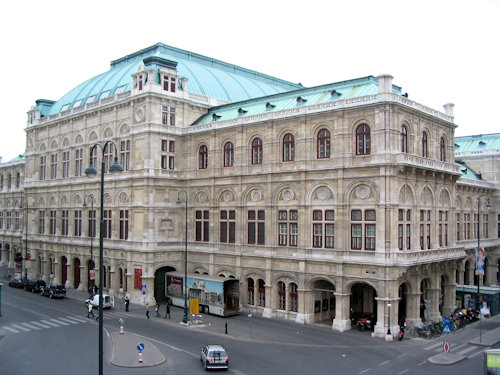
(The rear of the opera house)
As well as introducing various reforms at the opera house, Mahler also worked on the creative side of operations.
The Hofoper performed his production of Beethoven’s Fidelio 35 times, for example, and he conducted at five of those.
One of the rooms where you can enjoy an interval drink is named after him (the Gustav Mahler-Saal). It houses, for example, a travelling piano that once belonged to the celebrated composer. A tour of the opera includes the Saal.
Musikverein
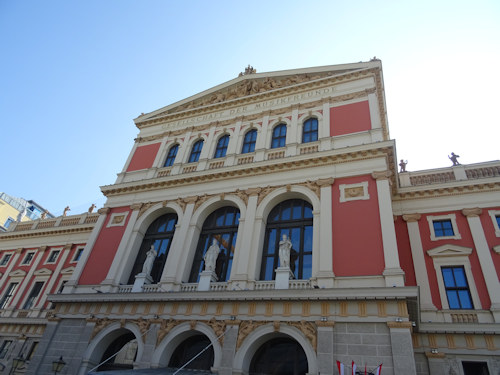
(One of the world’s great concert venues)
Inevitably, Mahler performed at Vienna’s top concert venue during his time at the Hofoper: a bust inside the Musikverein pays tribute to this connection. Other names intimately connected with the location include Brahms and Bruckner.
Mahler conducted the Wiener Philharmoniker in the Großer Musikvereinssaal many times, for example.
Max Oppenheimer immortalised that particular conductor-orchestra connection in his monumental painting The Philharmonic, which has Mahler at its very centre. The work featured in the 2023 Colossal exhibition at Lower Belvedere, for example.
Konzerthaus
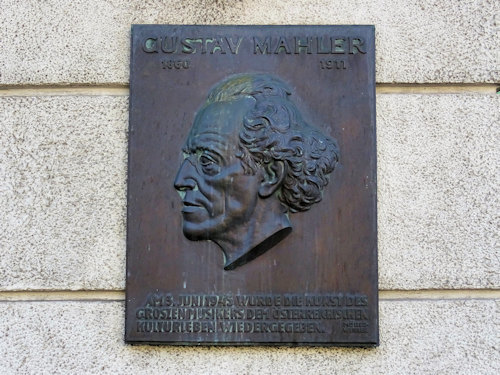
(Plaque as homage)
Although Mahler died before completion of the Konzerthaus, a 1945 plaque on the wall outside Vienna’s other major concert venue commemorates the “return” of his work to the city (my interpretation of the inscription) after the end of fascist rule in Austria.
The Nazis had previously deemed Mahler’s music as degenerate.
Secession
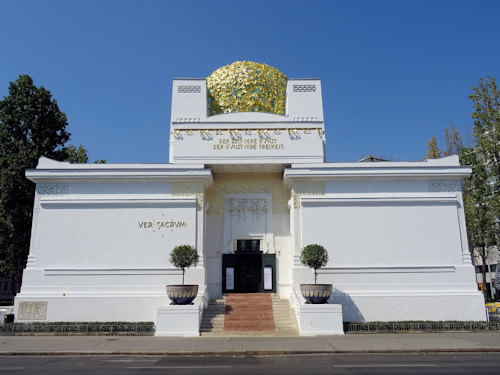
(The Secession from the Jugendstil era)
Mahler also conducted a brief arrangement of Beethoven at the Secession building for the opening of the celebrated 1902 Beethoven art exhibition put on by Gustav Klimt and colleagues.
Klimt’s Beethoven Frieze wall painting (still on view at the Secession) allegedly includes Mahler depicted as the Golden Knight.
Musical Instrument Collection
The Neue Burg wing of the Hofburg palace provides a home for the Historical Musical Instrument Collection, which forms part of the Kunsthistorisches Museum group of museums and collections.
One of the many keyboard instruments on display is a 1902 piano that belonged to Mahler.
Mahler: memorials & more
Mahler star

(A rather appropriate location)
The square immediately to the east of the Staatsoper has Mahler’s star embedded in the pavement (look opposite the fountain).
Haus der Musik

(View Mahler memorabilia within)
Think of the Haus der Musik as a museum of music and sounds. One floor has rooms dedicated to individual composers associated with Vienna, including one for Mahler.
As well as photos and other pieces of memorabilia, the museum has a score for the Marriage of Figaro with Mahler’s handwritten notes scribbled on it.
Mahlerstraße

(One of many streets here named after composers)
Pop out of the State Opera House’s east entrances and you find yourself opposite Mahlerstrasse, a street leading away down from Hotel Bristol (where Mahler once stayed) and along the edge of Vienna’s picturesque old town.
You might consider the street name representative of the entirety of Austrian history. Created in the late 1800s, it first bore the name Maximilianstraße, after the brother of the Emperor of the time.
Then in 1919, when Vienna began to disassociate itself from the now defunct Habsburg monarchy, the street became Mahlerstraße. This became Meistersingerstraße in 1938, named for a Richard Wagner opera (the Nazis at work), before reverting to Mahlerstraße in 1946 (shortly after Vienna’s “liberation” from the fascists).
The Wien Museum
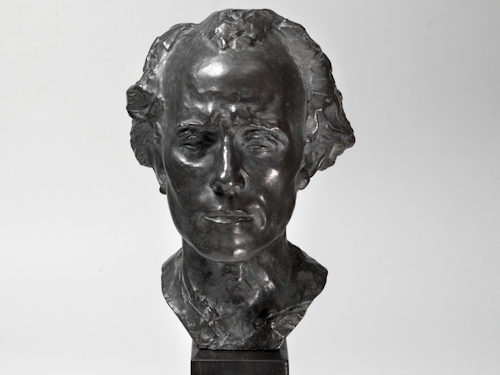
(The Rodin bust on display; Wien Museum Inv.-Nr. 96332; excerpt reproduced under the terms of the CC BY 4.0 license; photo by Birgit and Peter Kainz, Wien Museum)
The Fin de Siècle Vienna section of the Wien Museum’s permanent exhibition on Karlsplatz mentions Mahler’s contribution to “New Music”.
You can listen there to excerpts from the Kindertotenlieder song cycle and the Das Lied von der Erde symphonic song cycle. Auguste Rodin’s cast lead bust of Mahler from 1909 also makes an appearance.
Watch this space for more Viennese connections as I come across them…